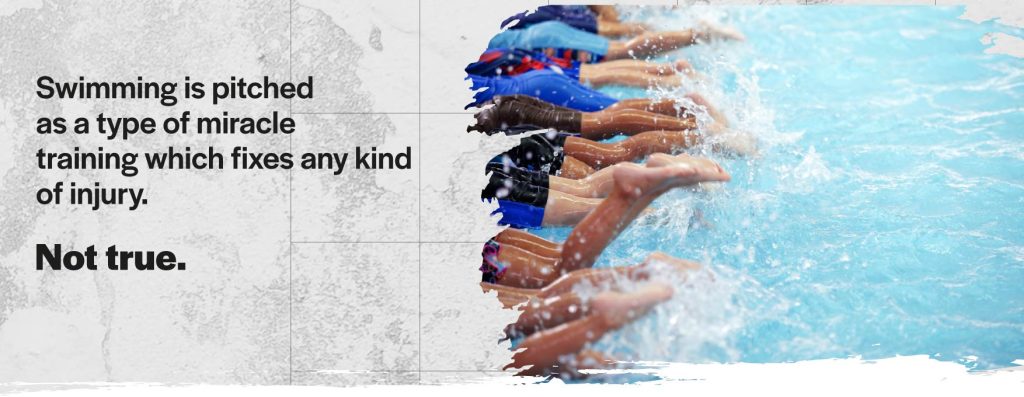Now this is a sport I love! I competed in swimming galas for years. I have to be objective though, people bang on about swimming as a type of miracle training which fixes any kind of injury.
That’s not true. Let’s break it down.
Load-free for the joints?
I’m sure you too have heard that all exercise in a swimming pool is not only injury free, but also a great tool to recover from existing injuries. The idea is that because we float in water, bones and joints move in a gentle way, without load. Cool, but there are two major flaws with this reasoning.
- Unless you are planning to float dead for an hour, there will be plenty of load on your joints. In fact, moving through water requires a greater effort than moving through air! The only difference is that forces will act in a different way than we’re used to on land. For instance, gravity won’t affect your spine vertically. But your spine will endure constant flexion/extension during backstroke drills, for example. The same goes for your knees: moving your legs up and down inside the water is basically like constantly kicking a penalty every step you make. So, yes, plenty of forces repeatedly acting on your joints.
- Is this really what we want? We and our spines have evolved to bear weight, alongside our knees, hips and ankles. Spending hours a week or whole days in water (if you are a pro), will eventually weaken your posture and stall the strengthening of your bones.
I know this isn’t a popular statement to make down by the pool, but it is scientifically proven. Every weight bearing exercise stimulates your bones to strengthen. When you’re swimming however, you don’t bear your bodyweight and there is no impact, only incessant, repeated strain in your joints. In fact, research shows that the bone density of a swimmer is comparable with the one of a sedentary individual. Yet they carry a similar risk of injuries.*
Swimmer’s slouch
Similarly, being in a hypo gravity environment too often, without the “push down” force, affects posture as well. I won’t get too technical but the myriad of tiny muscles along your back that keep you erect are not stimulated while in the water. At the same time, the ones at the front are strongly engaged. The imbalance gives rise to the infamous “swimmer’s slouch”, that sort of forward drag that many professionals and swimming enthusiasts develop [hyperlink].
In some circumstances, such as rehabilitation after serious surgery, swimming can be an extremely valid ally. More often than not it’s just like any other sport, with its pros, cons and risks.
I’m still a fan, swimming is unrivalled to build aerobic power and lung capacity, and it’s an invaluable means for a powerful upper body. With the simple precaution of a well-rounded strength programme on land run alongside your swimming routine you can cut the risks to virtually zero.
Also it’s the only fitness skill in the world which can save your life! If you were to be good at only one sport, sure, make it swimming!
Reference
*Gomez-Bruton, A., Gonzalez-Aguero, A., Gomez-Cabello, A., Casajus, J. A., Vicente-Rodriguez, G. (2013) ‘Is bone tissue really affected by swimming? A systematic review.’ PLOS ONE Open access, 8(8).






